Grasp the ancient art of Feng Shui Sand Gardens and discover tranquility and stress relief in your own backyard.
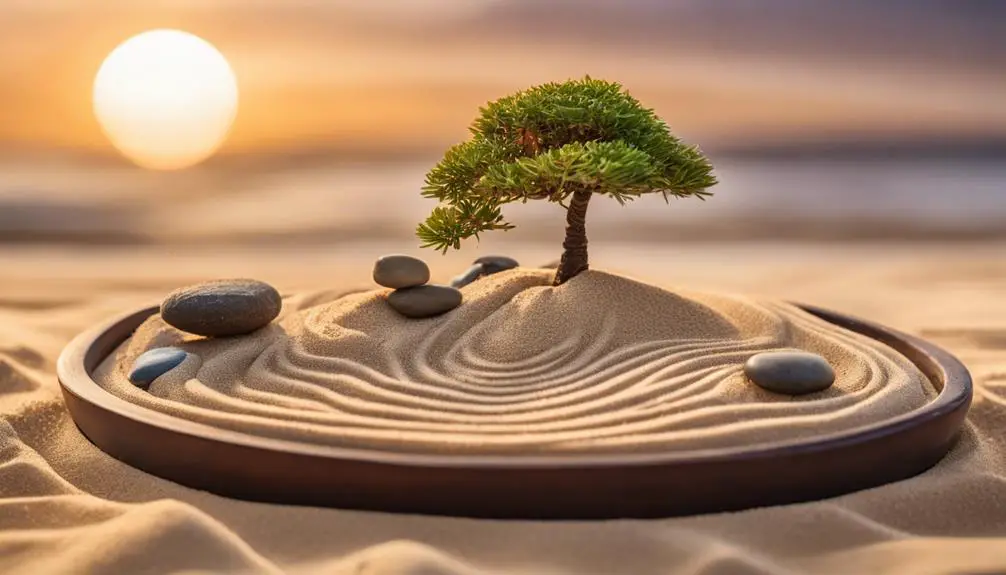
Feng Shui Sand Garden
Did you know that over 40% of Americans use some form of alternative therapy, including Feng Shui practices?
You're most likely familiar with Feng Shui in the context of interior design, but have you ever considered its application in the form of a sand garden?
The seemingly simple arrangement of sand, stones, and sometimes plants, can serve as a powerful tool for meditation and stress relief. But the philosophy and complexity underlying these tranquil spaces may surprise you.
Let's explore this ancient practice and how you might harness its benefits in your own backyard.
Key Takeaways
- Feng Shui sand gardens, rooted in ancient Chinese philosophy, serve as serene spaces for meditation, reflection, and energy balance.
- The sand, usually white for purity, and rocks in the garden symbolize water and mountains respectively, promoting stability and balance.
- Placement of the garden is vital; it should be in a quiet, peaceful area to encourage positive energy flow and avoid chaos.
- The creation process involves selecting clean sand, arranging stones strategically, using a rake to create patterns, and personalizing to resonate with individual energy.
Understanding the Feng Shui Philosophy
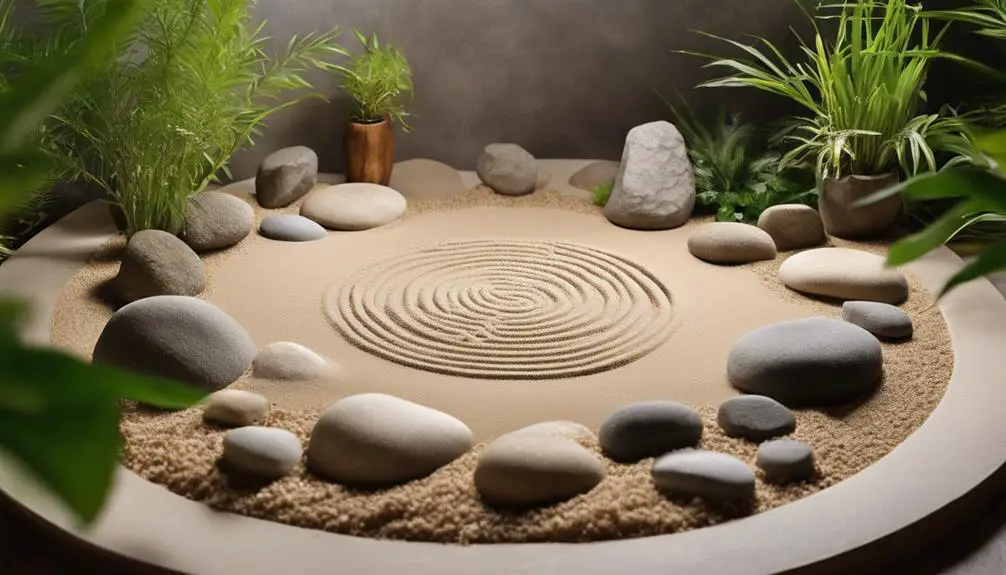
Before diving into the specifics of a Feng Shui sand garden, it's crucial to grasp the underlying philosophy of Feng Shui, a traditional Chinese concept that's all about harmonizing your environment to boost your wellbeing and prosperity.
The core Feng Shui principles revolve around the balance and flow of energy, or 'Chi', within a space. Everything in our surroundings, according to this philosophy, either generates, retains, or drains this invisible force. By arranging objects in a specific way, you can control and direct this energy flow to benefit your life.
The Yin and Yang theory plays a vital role in Feng Shui. It represents the dualities in life, such as male and female, dark and light, or warm and cool. It's not about choosing one over the other, but rather about achieving a balance between them. Yin and Yang are dynamic, with each containing the seed of the other, symbolizing that nothing is absolute.
In the context of a Feng Shui sand garden, every element, from the sand itself to the rocks and the rake, has a purpose and contributes to the overall energy balance. By understanding these principles, you'll be able to create a sand garden that not only looks beautiful but also harmonizes your environment.
Origins of Feng Shui Sand Gardens
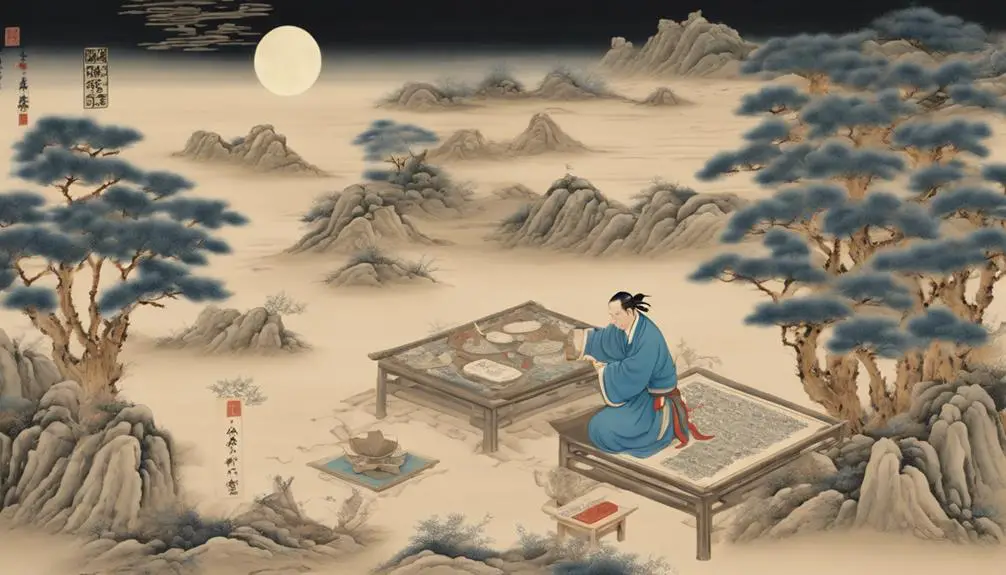
Often overlooked, the origins of Feng Shui sand gardens are deeply rooted in ancient Chinese culture, offering a unique perspective into the civilization's profound understanding of balance and harmony. This garden evolution isn't a random event; it's intricately tied to cultural symbolism and the principles of Feng Shui.
You'll find that the earliest Feng Shui sand gardens were likely extensions of traditional Chinese courtyard gardens, known for their meticulous arrangements and naturalistic design. These gardens were designed to mirror the cosmos, with sand representing water, a crucial element in the classical Chinese philosophy of balance.
Over time, you'll see how this original concept evolved into a more abstract aesthetic. The gardens started incorporating various elements such as rocks, symbolizing mountains, and the sand raked to represent water ripples. This evolution reflects the Chinese cultural symbolism, where mountains are viewed as the connection between heaven and earth, and water is synonymous with life's flow and transience.
Thus, the origins of Feng Shui sand gardens reflect not only the philosophical beliefs of ancient China but also the ongoing evolution of cultural aesthetics. So, as you delve deeper into Feng Shui sand gardens, remember their rich historical roots and the deep cultural symbolism they carry.
Significance of Feng Shui Sand Gardens
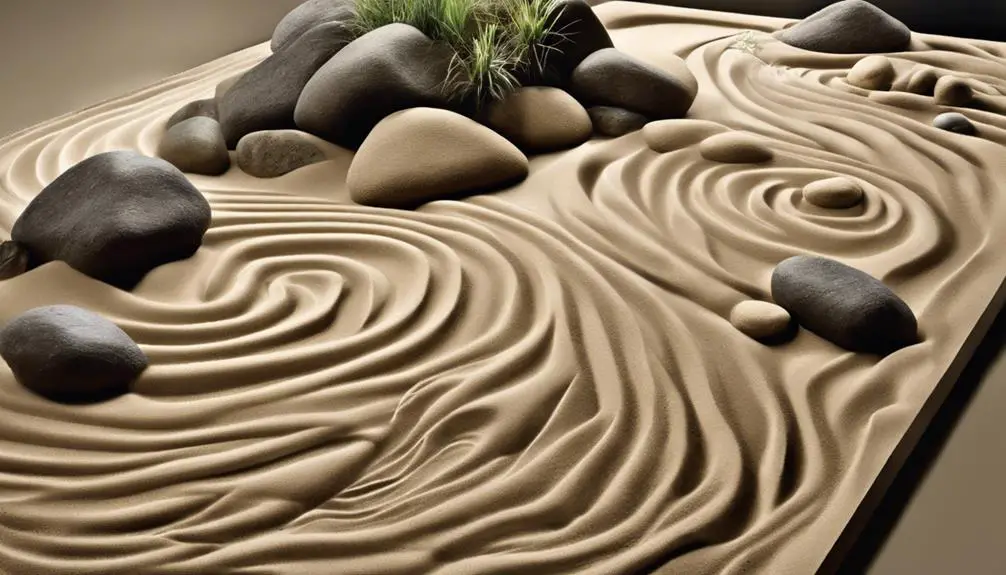
Understanding the significance of Feng Shui sand gardens, you'll uncover a wealth of cultural, spiritual, and aesthetic implications these carefully curated spaces hold. They aren't just about the beauty and serenity they bring. They also carry profound symbolic meanings that originate from ancient Chinese philosophy.
One key aspect you'll note is the sand color significance. In Feng Shui, different colors symbolize various elements and aspects of life. For instance, white sand represents purity, clarity, and transformation, promoting a peaceful and calm aura. Black sand, on the other hand, signifies depth, mystery, and the unknown, encouraging introspection. These colors aren't chosen randomly but are carefully selected to bring balance and harmony into your space.
Beyond traditional Feng Shui sand gardens, there are Zen garden alternatives that also uphold the principles of balance, simplicity, and naturalness. These gardens incorporate elements like stones, water features, and plants, creating a minimalist yet meaningful environment. They serve as a reflection of the natural world, offering a tranquil space for meditation and contemplation.
In essence, the significance of Feng Shui sand gardens extends beyond aesthetics. They're an embodiment of philosophical principles, designed to foster balance, peace, and spiritual growth.
Essential Elements for Your Garden
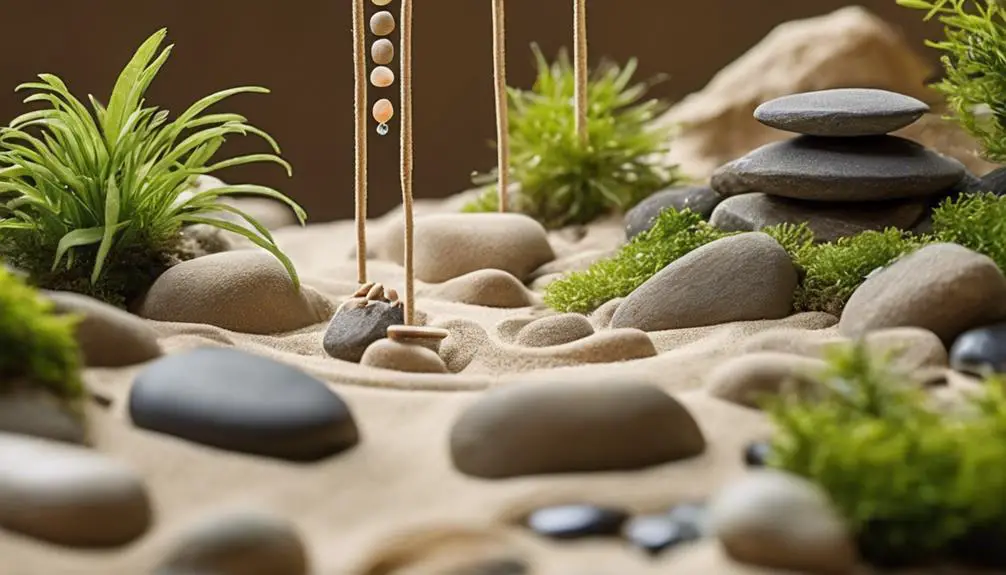
To create a harmonious Feng Shui sand garden in your own space, there are several essential elements you'll need to consider. 'Sand Selection' and 'Garden Placement' are two of the most prominent factors.
'Sand Selection' is crucial as the texture, color, and quality of the sand significantly influence the energy of your garden. Opt for natural, clean sand, avoiding artificially colored or chemically treated varieties. The sand should be raked regularly to maintain its smoothness and appeal, symbolizing the ever-changing nature of life.
'Garden Placement' should adhere to Feng Shui principles, ensuring positive energy flow. Your garden should be placed in a quiet, peaceful area, preferably with some sunlight. Avoid placing it in chaotic, high-traffic areas as it disrupts the tranquility.
Here's a basic guide:
| Essential Element | Tips |
|---|---|
| Sand Selection | Choose natural, clean sand. Avoid artificial, chemically treated sand. Rake regularly. |
| Garden Placement | Place in a quiet, calm area. Avoid high-traffic, chaotic locations. |
Step-by-Step Creation Process
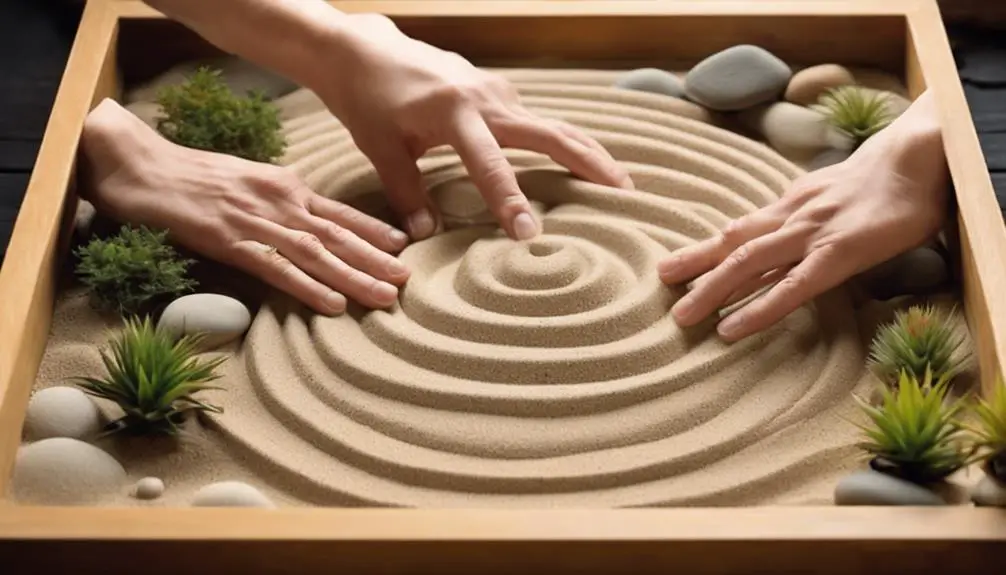
Creating your own Feng Shui sand garden isn't as daunting as it might seem; you just need to follow some easy steps. First, understand the importance of sand selection insights. The sand signifies water in Feng Shui, a crucial element for balance. Therefore, choose fine, clean white sand, symbolizing purity and clarity in life.
The second step involves the garden's location. The area should be serene, promoting a peaceful state of mind. It's best to place your garden in a quiet, calm spot, away from high traffic areas in your home. The garden location importance shouldn't be underestimated in Feng Shui.
Next, lay down the sand evenly, ensuring it covers the entire base of your chosen container. Now, place your selected stones strategically, representing mountains or islands. The arrangement should reflect your personal interpretation of the world, giving your garden a unique touch.
Lastly, use a small rake to create patterns in the sand, signifying ripples in water. These patterns can be straight lines for tranquility or circular for a dynamic energy flow. Remember, your Feng Shui sand garden is your personal sanctuary, and every element should resonate with your energy.
Maintaining Balance in Your Garden
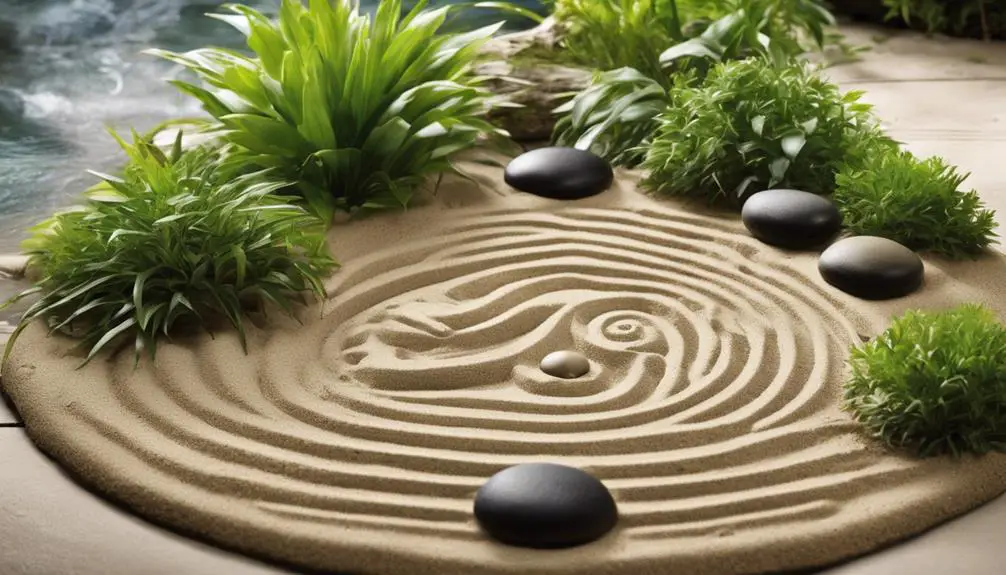
Once you've set up your Feng Shui sand garden, it's crucial to maintain its balance to continue harnessing its tranquility and positive energy. Achieving Garden Harmony involves careful and mindful Sand Placement.
You need to regularly rake your sand to keep it evenly distributed. Be conscious of the patterns you're creating as they can affect the energy flow. Keep the sand clean from debris to ensure a clear path for positive energy.
| Action | Importance | Frequency |
|---|---|---|
| Rake Sand | Maintain Evenness | Weekly |
| Create Patterns | Direct Energy Flow | As Needed |
| Clean Sand | Clear Energy Path | Daily |
Also, don't forget the importance of the elements in your garden. Each one has a role in maintaining the balance. For instance, stones represent the earth and provide stability. Placement of these stones can greatly affect the harmony.
Frequently Asked Questions
What Are Some Common Mistakes to Avoid When Setting up a Feng Shui Sand Garden?
When setting up, you might overlook the sand selection importance. But, don't. Using the wrong sand can disrupt harmony. Also, beware of incorrect placement consequences.
An ill-placed garden can obstruct positive energy flow. Always consider its location in relation to the house and other elements.
Can Feng Shui Sand Gardens Be Used Indoors?
Yes, you can use sand gardens indoors. However, sand selection and indoor placement are crucial for maintaining balance and harmony.
Choose natural, fine-grained sand and avoid artificial colors. When deciding on placement, find a quiet, well-lit area where the garden won't be disturbed.
How Can I Integrate Feng Shui Sand Gardens With Other Feng Shui Practices in My Home?
You can integrate sand gardens into your other Feng Shui practices effectively. Your sand selection is crucial; choose colors that align with your home's Feng Shui elements.
Garden placement also matters – position your garden in an area that needs balance. Use it as a meditation tool to promote positive energy flow.
Are There Any Specific Weather Conditions That Can Affect the Feng Shui Sand Garden?
Yes, weather conditions can certainly impact your sand garden. Rain, wind, or even intense sunlight can alter the sand quality, disrupting the intended energy flow. You'll need to regularly maintain it to counteract these weather influences.
It's best to locate your garden in a sheltered area, or consider an indoor sand garden if you live in an area with extreme weather conditions. Remember, the goal is to create a balanced, harmonious space.
Can I Use Colored Sand in My Feng Shui Sand Garden?
Absolutely, you can use colored sand in your project. It's vital to understand the sand selection importance. Different colors carry specific energy in Feng Shui.
For instance, green symbolizes growth and renewal, while red denotes passion and power. Therefore, the color of the sand you choose can significantly influence the energy flow.
It's not just about aesthetics, but also about creating a balanced, harmonious space. So, go ahead and add some color!
Conclusion
Embracing the philosophy of Feng Shui with a sand garden can bring harmony into your life. Understand the origins and significance, gather essential elements, and follow the creation process.
Remember, maintaining balance is key. So, don't just create, but nurture your garden, letting it be a constant reminder of the balance and tranquility you seek.
Explore Feng Shui, and let your garden be a peaceful sanctuary in your bustling world.


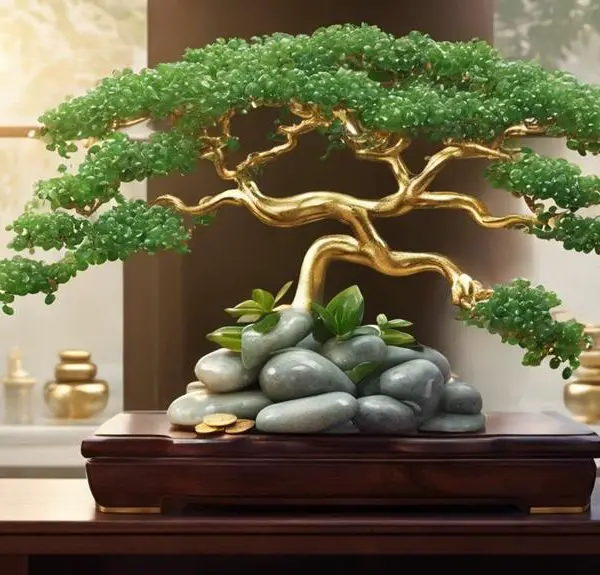
Sign up